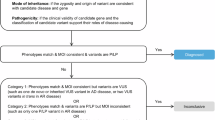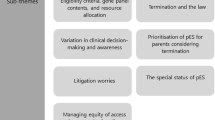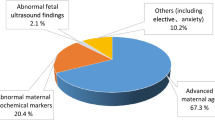Abstract
This study aims to assess prevalence and pregnancy outcome for sex chromosome trisomies (SCTs) diagnosed prenatally or in the first year of life. Data held by the European Surveillance of Congenital Anomalies (EUROCAT) database on SCT cases delivered 2000–2005 from 19 population-based registries in 11 European countries covering 2.5 million births were analysed. Cases included were livebirths diagnosed to 1 year of age, fetal deaths from 20 weeks gestation and terminations of pregnancy for fetal anomaly (TOPFA). In all, 465 cases of SCT were diagnosed between 2000 and 2005, a prevalence of 1.88 per 10,000 births (95% CI 1.71–2.06). Prevalence of XXX, XXY and XYY were 0.54 (95% CI 0.46–0.64), 1.04 (95% CI 0.92–1.17) and 0.30 (95% CI 0.24–0.38), respectively. In all, 415 (89%) were prenatally diagnosed and 151 (36%) of these resulted in TOPFA. There was wide country variation in prevalence (0.19–5.36 per 1000), proportion prenatally diagnosed (50–100%) and proportion of prenatally diagnosed resulting in TOPFA (13–67%). Prevalence of prenatally diagnosed cases was higher in countries with high prenatal detection rates of Down syndrome. The EUROCAT prevalence rate for SCTs diagnosed prenatally or up to 1 year of age represents 12% of the prevalence expected from cytogenetic studies of newborn babies, as the majority of cases are never diagnosed or are diagnosed later in life. There is a wide variation between European countries in prevalence, prenatal detection and TOPFA proportions, related to differences in screening policies as well as organizational and cultural factors.
Similar content being viewed by others
Log in or create a free account to read this content
Gain free access to this article, as well as selected content from this journal and more on nature.com
or
References
Jacobs PA, Melville M, Ratcliffe S, Keay AJ, Syme J : A cytogenetic survey of 11 680 newborn infants. Ann Hum Genet 1974; 37: 359–376.
Hamerton JL, Canning N, Ray M, Smith S : A cytogenetic study of 14 069 newborn infants. Clin Genet 1975; 8: 223–243.
Nielsen J, Sillesen I : Incidence of chromosome aberrations among 11 148 newborn children. Humangenetik 1975; 30: 1–12.
Morris JK, Alberman E, Scott C, Jacobs P : Is the prevalence of Klinefelter syndrome increasing? Eur J Hum Genet 2008; 16: 163–170.
Ratcliffe S : Long term outcome in children of sex chromosome abnormalities. Arch Dis Child 1999; 80: 192–195.
Abramsky L, Chapple J : 47,XXY (Klinefelter syndrome) and 47,XYY: estimated rates and indication for postnatal diagnosis with implications for prenatal counseling. Prenatal Diagnosis 1997; 17: 363–368.
Linden MG, Bender BG, Robinson A : Genetic counseling for sex chromosome abnormalities. Am J Med Genet 2002; 110: 3–10.
Leggett V, Jacobs P, Nation K, Scerif G, Bishop DVM : Neurocognitive outcomes of individuals with a sex chromosome trisomy: XXX, XYY or XXYA systematic review. Dev Med Ch Neurol 2010; 52: 119–129.
Otter M, Schrander-Stumpel CTRM, Curfs LMG : Triple X syndrome: a review of the literature. Eur J Hum Genet 2009; 18: 265–271.
Bishop DV, Jacobs PA, Lachlan K et al: Autism spectrum disorders, language and communication in children with sex chromosome trisomies. Arch Dis Child 2010, e-pub ahead of print 23 July 2010.
Abramsky L, Hall S, Levitan J, Marteau TM : What parents are told after prenatal diagnosis of a sex chromosome abnormality: interview and questionnaire study. BMJ 2001; 322: 463–466.
Forrester MB, Merz RD : Pregnancy outcome and prenatal diagnosis of sex chromosome abnormalities in Hawaii, 1986–1999. Am J Med Genet Part A 2003; 199: 305–310.
Marteau TM, Nippert I, Hall S et al: Outcomes of pregnancies diagnosed with Klinefelter syndrome: the possible influence of health professionals. Prenat Diagn 2002; 22: 562–566.
Brun JL, Gangbo F, Wen ZQ et al: Prenatal diagnosis and management of sex trisomy aneuploidy: a report of 98 cases. Prenat Diagn 2004; 24: 213–218.
Mezei G, Papp C, Toth-Pal E, Beke A, Papp Z : Factors influencing parental decision in prenatal diagnosis of sex chromosome aneuploidy. Obstet Gynecol 2004; 104: 94–101.
Boyd PA, DeVigan C, Khoshnood B, Loane M, Garne E, Dolk H, The EUROCAT Working Group: Survey of prenatal screening policies in Europe for structural malformations and chromosome anomalies, and their impact on detection and termination rates for neural tube defects and Down's syndrome. BJOG 2008; 115: 689–696.
Ferguson-Smith MA, Yates JRW : Maternal age specific rates for chromosome aberrations and factors influencing them: report of a collaborative European study on 52 965 amniocenteses. Prenat Diagn 1984; 4: 5–44.
EUROCAT, http://www.eurocat-network.eu.
Garne E, Khoshnood B, Loane M, Boyd P, Dolk H, EUROCAT working group: Termination of pregnancy for fetal anomaly after 23 weeks of gestation: a European register-based study. BJOG 2010; 117: 660–666.
Ekelund CK, Jorgensen FS, Petersen OB, Sundberg K, Tabor A, Danish Fetal Medicine Research Group: Impact of a new national screening policy for Down's syndrome in Denmark: population based cohort study. BMJ 2008; 337: a2547.
Lo YM : Non-invasive prenatal detection of fetal chromosomal aneuploidies by maternal plasma nucleic acid analysis: a review of the current state of the art. BJOG 2009; 116: 152–157.
Author information
Authors and Affiliations
Consortia
Corresponding author
Ethics declarations
Competing interests
The authors declare no conflict of interest.
Additional information
DISCLAIMER
This paper reports on an independent study which is part funded (Thames Valley, UK) by the Policy Research Programme in the Department of Health. The views expressed are not necessarily those of the Department.
Rights and permissions
About this article
Cite this article
Boyd, P., Loane, M., Garne, E. et al. Sex chromosome trisomies in Europe: prevalence, prenatal detection and outcome of pregnancy. Eur J Hum Genet 19, 231–234 (2011). https://doi.org/10.1038/ejhg.2010.148
Received:
Revised:
Accepted:
Published:
Issue date:
DOI: https://doi.org/10.1038/ejhg.2010.148
Keywords
This article is cited by
-
Early Social Behavior in Young Children with Sex Chromosome Trisomies (XXX, XXY, XYY): Profiles of Observed Social Interactions and Social Impairments Associated with Autism Spectrum Disorder (ASD)
Journal of Autism and Developmental Disorders (2023)
-
The impact of sex chromosome trisomies (XXX, XXY, XYY) on gaze towards faces and affect recognition: a cross-sectional eye tracking study
Journal of Neurodevelopmental Disorders (2022)
-
Effects of pre-pregnancy body mass index and gestational weight gain on maternal and infant complications
BMC Pregnancy and Childbirth (2020)
-
Lack of consensus in the choice of termination of pregnancy for Turner syndrome in France
BMC Health Services Research (2019)
-
Aneuploidy: a common and early evidence-based biomarker for carcinogens and reproductive toxicants
Environmental Health (2016)



